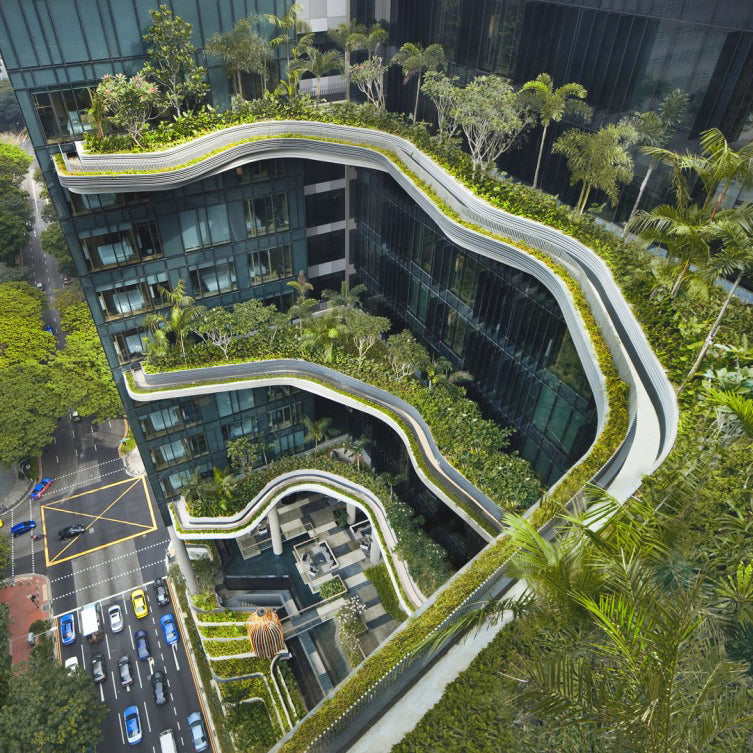
For millennia, human beings have lived close to nature; however, currently 54% of the world’s population are city dwellers, spending 93% of their time indoors. Due to the revitalizing properties of nature, a new concept called biophilic design has sprung up to solve this newfound disconnect between humans and nature.
What Exactly is Biophilic Design?

Biophilia literally means the love of nature, and the idea behind biophilic design is to embrace the fact that humans have an instinctual need to connect with nature. The biophilia hypothesis states that our evolution depended on nature for both our survival and personal fulfillment.
To put it simply, biophilic design brings elements of nature into indoor and urban environments. It can be as simple as filling a room with houseplants, or as complex as designing an entire urban landscape around biophilic principles.

With little connection to nature, and the increasing pressures of the urban environment and technology, people have little opportunity to revitalize their natural mental and physical vitality. Biophilic design strives to counteract the debilitating effects of modern, urban life by bringing nature indoors and into the city.
Biophilic design can use both direct and indirect experiences with nature. Direct experience is accomplished with indoor and outdoor plants, natural sunlight, and natural air ventilation. An indirect experience with nature can be the use of natural materials in building design and décor, for example, elements such as natural wood and stone, as well as earthy color schemes.
The Origin of Biophilic Design

While the term biophilia was coined recently by Edward O. Wilson in his 1984 book, Biophilia, biophilic design has been with humankind since the beginning of civilization.
Historically, biophilic design can be traced all the way back to the Hanging Gardens of Babylon; a marvel of the ancient world built by King Nebuchadnezzar II for his wife Queen Amytis. The Queen missed the green valleys and hills of her Median homeland, so the King built a towering series of tiered gardens with a wide variety of flowers, shrubs, vines and trees for her.
The Benefits of Biophilic Design
A growing body of evidence over the past 35 years shows that contact with nature makes people both healthier and happier. Here's a few places that you may have noticed biophilic design in:
Office:

Bringing nature into the office increases creativity and reduces absenteeism. Studies have shown that biophilic office design can increase productivity by 8%, with employee well-being increasing by 13%.
Hospitals:

Post-operative recovery time decreases by more than 8% for hospital patients with a view to the outside. Likewise, the use of pain medication was reduced by 22%.
Schools:

Institutions that incorporate biophilic design increased the rate of learning in students by 20-25%, as demonstrated by improved test results. Likewise, attendance and concentration levels improved, reducing the impact of ADHD on some students.
Residential:

Homes that utilize biophilic design elements are not only more beautiful and relaxing, but they can also command a higher property value and resale price. Likewise, neighborhoods with access to nature statistically have 7-8% less crime.
Retail:

As studies have found that the presence of plants boosts people's moods and increases human energy levels, retailers have begun to incorporate plants into their stores to both increase foot traffic and complement their own products. (H&M Hammersmith, UK includes trees and a florist)
Sustainable Design

Not only does biophilic design benefit the human spirit, but it also contributes to the health of the planet. Adding natural elements to the urban landscape reduces carbon emissions and increases natural biodiversity. Adding shade trees and landscaping to streets and parking lots can ease the urban heat island effect, thus reducing heating and cooling costs by 25% as well as reducing outdoor temperature fluctuations by 50%.
To put it simply, using biophilic design comes with many benefits, and few drawbacks. While the cost of implementing and maintaining a biophilic environment may cost a little more, the increased well-being and comfort biophilic design provides is priceless.
Try placing a few houseplants or an ēdn SmallGarden in your home or office to boost the biophilic design and reap the benefits.








